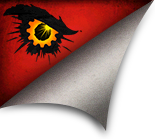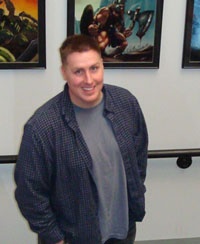How did you become a game artist? Can you tell us about what path you took?
I got my art degree from a junior college in traditional 2 dimension design/painting. I meddled with digital art here and there during school then eventually got an internship. A year after I graduated, I finally landed a full time spot. 17 years later I ended up here at SOE doing what I love, making games.
Did you ever think you'd end up as a game artist?
No, I didn't even think art was a valid career beyond illustration. I am glad I was wrong.
Which of these was your first love: games or art?
Games. I have always been a crazy gamer. I love computer games, online games, pen and paper role playing games, card games… you name it, I probably like playing it.
As an EQII Art Director, what does your job entail?
The first obvious answer is art direction,<haha>. Well, it does include, but is not exclusive to art direction. First off, myself and my co-worker Tim Heydelaar co-art direct Everquest II. We manage the art staff on day to day operations of art creation as well as help plan future expansions and live content. We do also generate some art, but typically our time is consumed by making sure everything works and progresses smoothly.
Tell us about the process of how you create art for a game project. What's a typical day like for you? What media or software programs do you use?
Creating art on Everquest II follows a standard that most studios use. Typically, we create a concept, then a textured 3D asset, animations, and finally a host of technical tidbits to make it work as an Everquest II game asset. This entire process varies in time greatly depending on the type of asset being created. Some assets take months to complete, others can be finished in just one day. The art department here on Everquest II uses a variety of software packages. Maya and Photoshop would be the two most common.
Making games is both a creative and a collaborative process. Tell us about how your art makes its way into the final game. Is there a lot of compromising, revising, and starting over from scratch?
Yes, yes and yes. Creating art to be used as a game asset has a series of challenges. The first is making the asset work within the game. If it doesn't work, it doesn't matter how pretty it is if you can't get it to be functional. Second is to make it look as good as possible within the time and game limitations. Once you get to that point, then changes, revisions, or sometimes a total re-purpose of the art asset occurs. Then the cycle starts over again. A typical hang-up is that most artists would work eternally on an asset to make it better. Usually some sort of compromise occurs just based on the time restrictions. Overall, the EverQuest II art staff strives to make art assets that will improve the player's gaming experience.
Please cite two games--one game you've worked on and one game you haven't worked on-that you felt had a very effective art style. What was so good about the art in each game?
Aero the Acrobat SNES 1993- At the time, Iguana was ahead of the curve graphically, and Aero proved that. I was very privileged to be apart of that elite crew at Iguana. Team Fortress 2 would be a game that I admire what they have done greatly. In this day and age a lot of companies are hung up on 'realistic' art. TF2 proved that fun visual that are stylized instead of photo-real can be very successful.
What are the most exciting and rewarding parts of being a game artist? Seeing your creations come to life? Working with your team? Creating something new?
For me personally, First and foremost, I am making games. Sort of my way of being an entertainer (Making games is my second love in life. My first being my lovely wife.) The second is that I am using my skills as an artist. I enjoy creating art and especially if it is game art.
As game technology advances, it's becoming much harder and more time consuming to make a visually impressive game with high-resolution textures, more environmental objects, facial animations, and so on. What are your thoughts on art and art assets in games in this and the next generation?
You just described the trap most game developers fall in. They focus on visuals more than making the game fun. Yes it is important to make the game look good, but it does not require 'next gen' or 'cutting edge' to be a great game. A good example of this is the success of casual web based games. Now, for the future of MMO graphics the solution is in procedural art solutions with a high degree of quality control. There are too many assets to hand generate them all unless you have a small army of artists at your disposal.
People have a misconception that when you become a video game designer or artist you play games all day. Is that ever true?
No, this is software development. The product we develop just happens to be a game.
Do you have any advice for aspiring game artists out there? What kind of training and preparation would be good for game artists in this day and age?
Compare your art to existing game art. If your art meets those standards then you will be considered. Also, do not show art that does not meet the gaming standards. If you can only show one piece of art then only show one. Most companies will ask for more and or give you an art test. As far as training, Art institutes around the country are great places to get the fundamentals to be ready for an entry level position in the games industry.
Finally, what is your favorite videogame of all time?
Wow, that is a hard question. I cannot really pick one. It would be more like a top 10 or 20. Games like: Counter Strike, Pool of Radiance, Mechwarrior, Command and Conquer, Starcraft, Quake, Baldur's Gate, Company of Heroes, to name a few.


